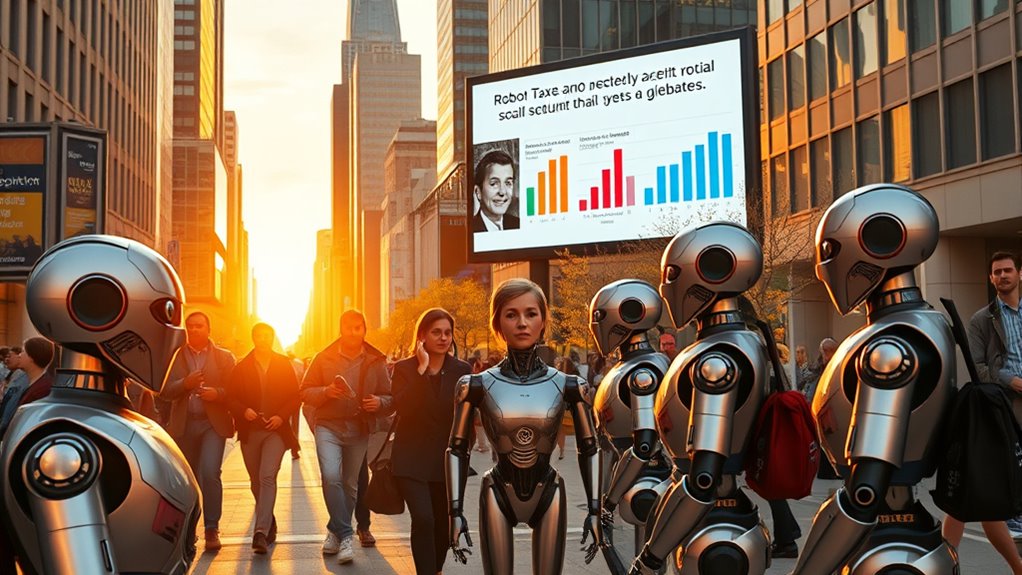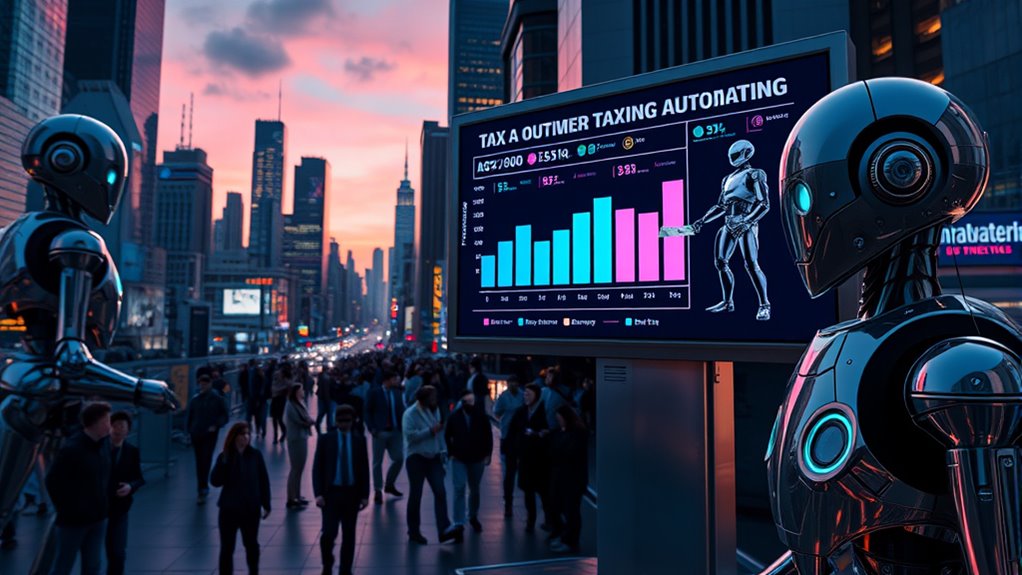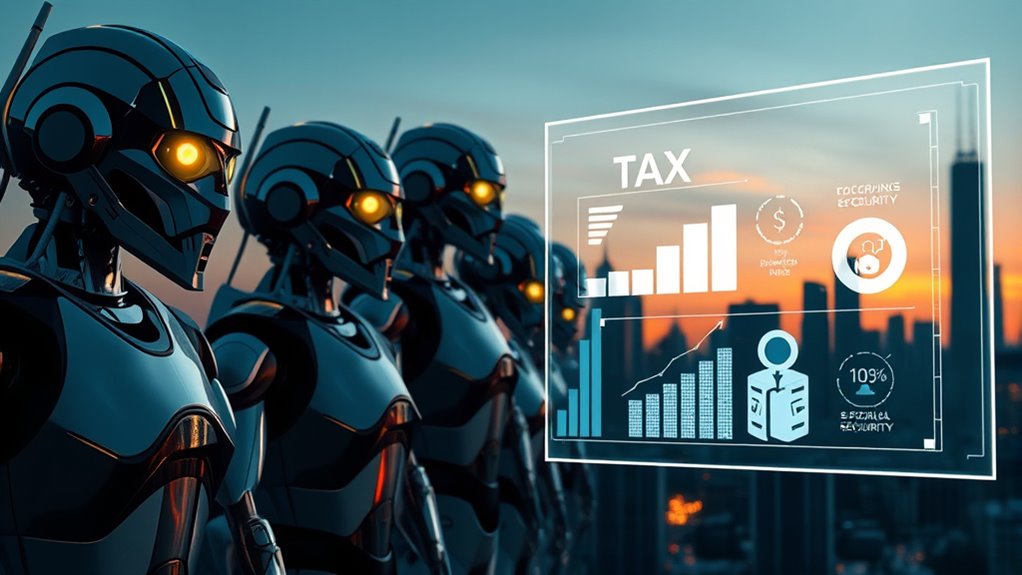Taxing robots could help stabilize Social Security by offsetting revenue losses from automation, which reduces payroll tax income. As companies adopt more robots, this tax could generate funds for social programs, safety nets, and worker retraining. Though it might slow innovation or raise challenges in implementation, targeted robot taxes paired with fair income policies offer a promising way to balance growth and social fairness. To explore how these strategies work together, keep exploring this important topic.
Key Takeaways
- Automation reduces payroll tax revenue, threatening long-term Social Security funding without policy intervention.
- Implementing robot taxes can generate revenue to support Social Security and social safety nets.
- Carefully designed robot taxes can balance innovation incentives with social equity needs.
- Revenue from robot taxes can fund social programs like retraining and basic income, stabilizing Social Security.
- International cooperation and clear policies are essential to effectively tax robots and safeguard social security.
The Impact of Automation on Federal Revenue and Social Security Funding

Automation is changing how federal revenue is generated, especially through its effects on employment and payroll taxes. As firms automate, they typically reduce wage bill growth, leading to slower employment increases—about 1.5 percentage points less than non-automating firms. This slowdown translates into lower payroll tax contributions, which fund Social Security. Although some companies maintain hiring and see higher revenue growth, most expect slower job growth overall. There’s no clear evidence that increased automation boosts other tax streams enough to offset the decline in payroll taxes. While automation might improve productivity and profits, current data don’t show a direct link to higher federal or Social Security revenues. Without intervention, widespread automation could result in slower payroll tax growth, threatening long-term Social Security funding. Automation’s impact on tax revenues remains uncertain, emphasizing the need for proactive policy adjustments. Additionally, the potential for tax revenue shifts due to automation underscores the importance of exploring alternative funding mechanisms for Social Security.
Economic Rationale and Optimal Tax Strategies for Robot Integration

To navigate the integration of robots effectively, you need to balance efficiency gains with social equity concerns. Implementing ideal tax rates can help address income inequality caused by automation while supporting economic growth. Robots have contributed approximately 10% to GDP growth per capita in OECD countries from 1993 to 2016. Additionally, understanding the impact of automation on employment can guide policymakers in developing effective taxation strategies. Ultimately, choosing the right redistribution policies ensures that both productivity and social stability are maintained.
Balancing Efficiency and Equity
Balancing efficiency and equity in robot integration requires careful consideration of both economic benefits and social costs. You need to weigh how automation boosts productivity against its potential to displace workers and widen inequality. Implementing robot taxes can help address these issues by:
- Providing revenue to support social safety nets and fund retraining programs
- Redistributing wealth to reduce income gaps caused by automation
- Mitigating revenue losses from declining labor taxes due to job displacement
- Ensuring technology adoption doesn’t stifle innovation through overly high taxes
- Promoting policy harmonization to balance growth with social stability
- Empirical evidence suggests that targeted taxation can effectively reduce inequality while supporting innovation.
- Incorporating equitable tax policies can further enhance social acceptance and long-term sustainability of automation initiatives.
While automation can drive economic growth, unchecked displacement risks social cohesion. Striking the right balance involves designing strategies that maximize efficiency without sacrificing social fairness.
Optimal Tax Rate Insights
Determining the most favorable tax rate for robots requires balancing the incentives for innovation with the need to address economic inequality. Initially, a low subsidy of about 0.5% can encourage adoption, boosting productivity. Over time, as robots become cheaper and more common, ideal tax rates could rise to around 1%. However, these rates should decrease if efficiency gains outweigh redistributive benefits. Unlike equipment capital, robot taxes are generally lower and may decline over decades, potentially reaching zero. Taxing robots influences labor markets and occupational choices; if workers shift to non-routine jobs, the policy’s impact diminishes. Welfare gains are higher without occupational switching, but overall, robot taxes work best when combined with broader income tax strategies that promote progressivity and labor supply responses. Additionally, ongoing discussions about AI vulnerabilities highlight the importance of safety measures that could influence future policy considerations.
Redistribution Policy Effectiveness
Implementing effective redistribution policies through taxation becomes increasingly important as automation reduces the number of jobs and erodes government revenue streams. You need to examine that taxing robots could help offset lost payroll taxes and provide alternative funds for social security. However, these taxes might be less effective than direct income redistribution for improving welfare. Additionally, taxing capital like robots may create efficiency costs that could outweigh redistributive benefits. For example, maximize space and organization strategies can help create more efficient use of existing resources, reducing the need for excessive consumption and waste.
- Robots as capital face lower tax rates, encouraging automation.
- Automation decreases income tax revenue, impacting public funds.
- Robots don’t contribute to social security, risking funding shortfalls.
- Increasing taxes on capital could introduce economic inefficiencies.
- Combining robot taxes with progressive income taxes can maximize welfare.
Public Support and Political Perspectives on Robot Taxes

Are public and political attitudes toward robot taxes shifting as automation advances? Public opinion is mixed but aligns with broader debates about AI policies, like higher corporate taxes and stronger safety nets. Some surveys show that a portion of people support taxing robots, especially amid concerns about automation’s impact on jobs and inequality. Politicians and leaders, including figures like Bill Gates, see robot taxes as a way to address economic shifts and declining tax revenues from displaced workers. The EU is exploring different tax approaches for robots, emphasizing the need to balance innovation with social fairness. Overall, support varies, but many see robot taxes as a tool to fund social programs and reduce inequality, making them an important part of ongoing policy discussions. Additionally, understanding the dynamic relationships between different personality disorders can inform policy approaches aimed at social welfare and mental health support.
Challenges in Defining and Implementing a Robot Tax

Defining what qualifies as a robot for tax purposes is inherently complex because these technologies vary widely in form and function. You face challenges like:
Defining robots for tax purposes is complex due to their diverse forms and functions.
- Definitional Challenges: No single, stable definition exists, making classification difficult. Understanding technological diversity is crucial to develop effective tax policies.
- Legal Implications: Ambiguity can lead to disputes and enforcement issues.
- Technical Considerations: Diverse applications require adaptable tax frameworks.
- Industry Variability: Different sectors use robots uniquely, needing tailored approaches.
- International Standards: Global consensus could streamline policies but remains elusive.
These complexities hinder straightforward implementation. You must balance precision with flexibility, ensuring the tax captures relevant automation without stifling innovation. Developing clear, consistent rules demands international cooperation and ongoing legal adjustments, making the process far from simple. Additionally, technological diversity means that any definition must be sufficiently broad to encompass new and evolving systems.
Effects of Robot Taxation on Business Investment and Employment

Robot taxes can influence how businesses decide to invest in automation, potentially reducing incentives to adopt new technologies. They also impact employment by raising concerns about job displacement and workforce skills. Ultimately, these policies shape overall productivity and economic growth, making their effects essential to understand. For example, considering Kia Tuning, modifications and upgrades can significantly alter a vehicle’s performance and appearance, similar to how policy changes can affect technological advancements and economic outcomes.
Automation Investment Incentives
Investing in automation offers countries a strategic advantage by boosting productivity and strengthening global competitiveness. Tax incentives are widely used to encourage automation investments, helping nations stay ahead economically. However, imposing a robot tax could reduce incentives, potentially pushing investment overseas. Higher tax rates are linked to increased robot density, as seen in Germany and Japan, indicating that taxes influence automation levels. You need to contemplate that:
- Tax incentives can make automation more attractive, increasing investment.
- A robot tax might raise costs, discouraging automation investments.
- Countries with higher taxes often see more robot adoption, possibly due to strategic choices.
- Policymakers must balance tax revenue with maintaining innovation momentum.
- Overly high taxes could hinder technological progress, affecting long-term growth.
Ultimately, incentives shape where and how businesses invest in automation, impacting economic competitiveness.
Employment Displacement Effects
How does the adoption of automation influence employment, especially for routine tasks? Robots often replace low-skilled, routine jobs, leading to unemployment and increased social security concerns. However, in some countries with high automation, unemployment remains low, suggesting automation doesn’t always cause job loss. Still, low-skilled workers face higher displacement risks, worsening income inequality. While automation boosts productivity, a robot tax might slow innovation, potentially reducing new employment opportunities. Conversely, taxing robots could incentivize businesses to invest more in human workers and skills development. The impact on employment varies by context, but overall, automation’s displacement effects raise concerns about job security, income disparity, and the future of social safety nets. Incorporating evidence‑based insights can help policymakers develop balanced strategies to address these challenges.
Productivity and Growth
Automation can considerably boost a country’s productivity and economic growth, but the way it’s taxed influences business investment decisions. High taxes don’t always deter robot adoption; instead, countries like Germany and Japan see more investment in robots when supported by favorable tax policies. Tax incentives, such as Taiwan’s tax credits, can stimulate automation and increase tax revenues over time. Additionally, tax policy frameworks play a crucial role in shaping a nation’s approach to automation investments. However, robot taxes might shift investments abroad, harming domestic competitiveness by encouraging companies to relocate. Automation’s positive impact on GDP has led many nations to reconsider their tax strategies to attract and retain robotic investments.
- Capital investment tends to favor nations with supportive tax structures
- High corporate taxes may not prevent automation if incentives exist
- Robot taxes could push investments to countries with better tax policies
- Tax policies influence multinational decisions on automation levels
- Balancing taxes and incentives is essential for sustained growth
Potential Revenue Generation and Social Security Stabilization

Implementing a robot tax presents a promising way to generate additional government revenue, which can be essential for stabilizing social security systems. A tax of 1% to 3.7% on robot value could produce significant funds, especially in countries with high corporate tax rates and widespread automation. These revenues could be redirected to support social programs like universal basic income or help displaced workers, reducing social security strain. While concerns exist that taxing robots might slow innovation, carefully designed policies can balance growth and revenue. The extra income from robot taxes could lessen reliance on payroll taxes, ensuring long-term sustainability. By encouraging sectors less prone to automation, a robot tax can diversify economic activity and reinforce social security’s financial foundation. Empirical data also indicates that the impact of automation on tax revenues has been relatively stable in recent years, supporting the feasibility of such a policy.
Comparing Robot Taxes to Income and Capital Tax Reforms

While taxing robots offers a way to raise revenue and address inequality, it’s important to compare this approach with reforms to existing income and capital taxes. Income tax reforms, especially on labor income, tend to generate greater welfare improvements and are more direct in redistribution. Conversely, robot taxes risk inhibiting innovation and economic growth due to efficiency costs.
Consider these points:
- Income and capital tax reforms are more effective at boosting welfare than robot taxes.
- Robot taxes may deter technological progress, which indirectly raises productivity and income.
- Firms can avoid robot taxes by replacing human labor, reducing their effectiveness.
- Payroll tax losses from automation challenge social security funding more than direct robot taxes.
- Historically, taxing new automation technologies has been rare, favoring productivity gains over direct taxation.
- International cooperation can help mitigate some of these issues by establishing fair and consistent tax policies across borders.
Policy Considerations for Balancing Innovation, Fairness, and Fiscal Sustainability

Balancing innovation, fairness, and fiscal sustainability requires careful policy design that addresses the diverse impacts of automation. You need to take into account how taxing robots can mitigate job losses and revenue shortfalls, supporting social equity by redistributing wealth generated through automation. While a robot tax could help fund social services and guarantee fiscal health, it might also slow innovation and economic growth, affecting job creation and productivity. You must weigh the benefits of increased revenue against potential negative effects on technological progress. Additionally, designing clear legal frameworks and defining what qualifies as a robot are vital. International differences further complicate implementation. Research indicates that careful policy design can help address inequality while promoting technological progress. Ultimately, policies should promote technological advancement while safeguarding social fairness and long-term fiscal stability.
Frequently Asked Questions
How Would a Robot Tax Impact Overall Economic Growth?
You might wonder how taxing robots impacts economic growth. A robot tax could boost growth by generating revenue that funds public programs, encouraging firms to retain human workers, and attracting capital investments. However, it may also hinder innovation and slow technological progress if the tax is too high. Balancing the rate is key, as modest taxes could support growth without discouraging automation and productivity improvements.
Could Robot Taxes Lead to Increased Automation in Unregulated Sectors?
You might worry that robot taxes could push automation into unregulated sectors. Companies keen to avoid taxes may shift their investments, increasing automation where regulations are weaker. This could lead to more job displacement in these sectors, making it harder to control automation growth. To prevent this, you’ll need all-encompassing policies and international cooperation to guarantee taxes aren’t bypassed and automation remains balanced across all industries.
What International Models Exist for Taxing Automated Capital?
You want to know about international models for taxing automated capital. Countries like France, the UK, India, and Nigeria have implemented digital services taxes, which inform robot tax debates. The OECD promotes coordination to prevent tax evasion and competition. Some nations consider graduated rates based on automation levels or robot age. These models aim to balance revenue generation, innovation, and social equity, but they face measurement and implementation challenges.
How Can Policymakers Ensure Fairness in Robot Tax Implementation?
You want fairness in robot tax implementation, so you must set clear definitions, establish transparent rules, and guarantee consistent enforcement. You should differentiate between simple automation and AI-driven robots, design fair tax rates that don’t stifle innovation, and allocate revenues responsibly to support displaced workers. You need to promote fairness through fairness in classification, fairness in taxation, and fairness in the use of funds, building trust and encouraging compliance.
What Are Alternative Strategies to Finance Social Security Amid Automation?
You’re exploring ways to fund Social Security as automation grows. Instead of taxing robots, you might boost payroll taxes from high earners, increase investment in trust funds, or implement policy reforms like raising the retirement age. Encouraging workers to save more privately and managing costs effectively also help. Engaging the public and exploring international models can offer additional solutions, making the system more sustainable without solely relying on robot taxes.
Conclusion
By taxing robots, you could provide a steady funding stream for Social Security, much like how a small business might reinvest profits to ensure growth. Imagine a factory that automates assembly lines but pays a robot tax, helping fund retirements. While challenges exist, embracing smart policies can balance innovation and fairness. If done right, robot taxes could secure your future social benefits while encouraging responsible automation.









